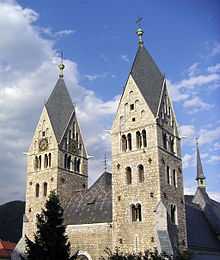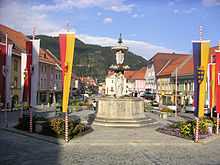Friesach
| Friesach | ||
|---|---|---|
 | ||
| ||
 Friesach | ||
| Coordinates: 46°57′N 14°25′E / 46.950°N 14.417°ECoordinates: 46°57′N 14°25′E / 46.950°N 14.417°E | ||
| Country | Austria | |
| State | Carinthia | |
| District | Sankt Veit an der Glan | |
| Government | ||
| • Mayor | Josef Kronlechner (SPÖ) | |
| Area | ||
| • Total | 120.83 km2 (46.65 sq mi) | |
| Elevation | 634 m (2,080 ft) | |
| Population (1 January 2013)[1] | ||
| • Total | 5,085 | |
| • Density | 42/km2 (110/sq mi) | |
| Time zone | CET (UTC+1) | |
| • Summer (DST) | CEST (UTC+2) | |
| Postal code | 9360 | |
| Area code | 04268 | |
| Website | www.friesach.at | |
Friesach (Slovene: Breže) is a historic town in the Sankt Veit an der Glan district of Carinthia, Austria. First mentioned in a 860 deed, it is known as the oldest town in Carinthia.

Geography
Location
Friesach covers an area of 120.83 km² and its mean elevation is 631 meters above sea level. It is located in northern Carinthia near the border with Styria, about 40 km (25 mi) north of its capital Klagenfurt.
Municipal arrangement
Friesach is divided into the following Katastralgemeinden: Friesach, St. Salvator and Zeltschach.
It can be further divided into Friesach proper and the villages and hamlets of Dobritsch, Dörfl, Engelsdorf, Gaisberg, Grafendorf, Guldendorf, Gundersdorf, Gunzenberg, Gwerz, Harold, Hartmannsdorf, Hundsdorf, Ingolsthal, Judendorf, Kräuping, Leimersberg, Mayerhofen, Moserwinkl, Oberdorf I, Oberdorf II, Olsa, Pabenberg, Reisenberg, Roßbach, Sattelbogen, Schratzbach, Schwall, Silbermann, St. Johann, St. Salvator, St. Stefan, Staudachhof, Stegsdorf, Timrian, Wagendorf, Wels, Wiegen, Wiesen, Zeltschach, Zeltschachberg, Zienitzen, Zmuck.
History
In 860 King Louis the German of East Francia donated the lands of the estate ad Friesah - derived from Slavic Breza (birch) - in the Bavarian March of Carinthia (Carantania) to Archbishop Adalwin of Salzburg. From about 740 Bavarians had crossed the Central Eastern Alps and settled among the Slavic Carantanians.

After the formation of the Duchy of Carinthia in 976, Friesach remained a southern Salzburg exclusive and a strategically important outpost. About 1076 Archbishop Gebhard of Salzburg, a follower of Pope Gregory VII in the Investiture Controversy, had the Petersberg fortress erected above the town in order to prevent Emperor Henry IV from crossing the Alps. The archbishop also had fierce enemies in the Carinthian ducal House of Sponheim, who after his deposition made several attempts to take possession of Friesach. Constant attacks by Duke Engelbert were finally rejected in 1124. In 1149 King Conrad III of Germany stayed at the castle on his way back from the Second Crusade, as well as Richard the Lionheart in 1192, one more time escaping from the guards of Duke Leopold V of Austria. The fortress continued to be an important power basis of the Salzburg prince-archbishops throughout the Middle Ages, once again enlarged and strengthened by Leonhard von Keutschach from 1495 onwards.
The settlement of Friesach beneath Petersberg Castle received town privileges in 1215. During the Middle Ages, it was a principal market town and commercial centre due to an important trade route from Vienna to Venice that ran through the city. The town flourished when Archbishop Eberhard II of Regensberg (1200-1246) made it the second largest city in the Archdiocese of Salzburg and the most important town in Carinthia. From local silver resources it even minted its own currency called the Friesacher Pfennig or Frizatik, widely used within the Austrian and Hungarian lands in the 12th century. The importance of the town diminished with the rise of the House of Habsburg, Carinthian dukes since 1335. It nevertheless belonged to Salzburg until the secularisation of the archbishopric in 1803, when Friesach finally fell to Carinthia.
Demographics
As of the 2001 census, Friesach has 5,335 inhabitants. Of that, 89.8% are Roman Catholic, 2.6% are Evangelist and 1.5% are Muslims. 4.8% of the population is non-religious.
Objects of interest


The mediæval town around the Romanesque parish church of Saint Bartholomew and its city walls are preserved in quite good condition. From the 13th century on the Salzburg Archbishops stayed at the Fürstenhof residence. Furthermore:
- Church of St. Blaise
- Dominican monastery
- Teutonic Knights' church and hospital
Economy
Friesach has several small to medium-sized industries, including metalworking and textilemaking. Like most regions of Carinthia, the town mainly depends on tourism. With the Teutonic Order hospital, it is also a supraregional health centre.
Politics
Municipal Council
As of the 2009 elections, Friesach's local council (Gemeinderat) consists of 23 members of the following parties:
- 13 SPÖ
- 5 LSM (Independent)
- 3 BZÖ
- 2 BFF (Independent)
- 1 FPÖ
Twin towns
Friesach is twinned with:
Born in Friesach
- Josef Bucher, August 19, 1965, politician
- Gerda Hofstatter, February 9, 1971, professional billiards player
- Robert Stadlober, August 3, 1982, actor
- Jürgen Säumel, September 8, 1984, football player
References
External links
| Wikimedia Commons has media related to Friesach. |
| |||||
